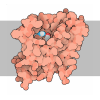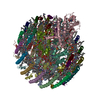[English] 日本語
 Yorodumi
Yorodumi- PDB-8z81: Photosynthetic LH2-LH1 complex from the purple bacterium Halorhod... -
+ Open data
Open data
- Basic information
Basic information
| Entry | Database: PDB / ID: 8z81 | |||||||||||||||||||||
|---|---|---|---|---|---|---|---|---|---|---|---|---|---|---|---|---|---|---|---|---|---|---|
| Title | Photosynthetic LH2-LH1 complex from the purple bacterium Halorhodospira halophila | |||||||||||||||||||||
 Components Components | (Antenna complex, alpha/beta ...) x 6 | |||||||||||||||||||||
 Keywords Keywords | PHOTOSYNTHESIS / LH2-LH1 COMPLEX | |||||||||||||||||||||
| Function / homology |  Function and homology information Function and homology informationorganelle inner membrane / plasma membrane light-harvesting complex / bacteriochlorophyll binding / photosynthesis, light reaction / metal ion binding / plasma membrane Similarity search - Function | |||||||||||||||||||||
| Biological species |  Halorhodospira halophila (bacteria) Halorhodospira halophila (bacteria) | |||||||||||||||||||||
| Method | ELECTRON MICROSCOPY / single particle reconstruction / cryo EM / Resolution: 2.2 Å | |||||||||||||||||||||
 Authors Authors | Tani, K. / Nagashima, K.V.P. / Kanno, R. / Hiwatashi, N. / Kawakami, M. / Nakata, K. / Nagashima, S. / Inoue, K. / Takaichi, S. / Purba, E.R. ...Tani, K. / Nagashima, K.V.P. / Kanno, R. / Hiwatashi, N. / Kawakami, M. / Nakata, K. / Nagashima, S. / Inoue, K. / Takaichi, S. / Purba, E.R. / Hall, M. / Yu, L.-J. / Madigan, M.T. / Mizoguchi, A. / Humbel, B.M. / Kimura, Y. / Wang-Otomo, Z.-Y. | |||||||||||||||||||||
| Funding support |  Japan, 6items Japan, 6items
| |||||||||||||||||||||
 Citation Citation |  Journal: Nat Commun / Year: 2025 Journal: Nat Commun / Year: 2025Title: A distinct double-ring LH1-LH2 photocomplex from an extremophilic phototroph. Authors: Kazutoshi Tani / Kenji V P Nagashima / Risa Kojima / Masaharu Kondo / Ryo Kanno / Issei Satoh / Mai Kawakami / Naho Hiwatashi / Kazuna Nakata / Sakiko Nagashima / Kazuhito Inoue / Yugo Isawa ...Authors: Kazutoshi Tani / Kenji V P Nagashima / Risa Kojima / Masaharu Kondo / Ryo Kanno / Issei Satoh / Mai Kawakami / Naho Hiwatashi / Kazuna Nakata / Sakiko Nagashima / Kazuhito Inoue / Yugo Isawa / Ryoga Morishita / Shinichi Takaichi / Endang R Purba / Malgorzata Hall / Long-Jiang Yu / Michael T Madigan / Akira Mizoguchi / Bruno M Humbel / Yukihiro Kimura / Yutaka Nagasawa / Takehisa Dewa / Zheng-Yu Wang-Otomo /    Abstract: Halorhodospira (Hlr.) halophila strain BN9622 is an extremely halophilic and alkaliphilic phototrophic purple sulfur bacterium isolated from a hypersaline lake in the Libyan Desert whose total ...Halorhodospira (Hlr.) halophila strain BN9622 is an extremely halophilic and alkaliphilic phototrophic purple sulfur bacterium isolated from a hypersaline lake in the Libyan Desert whose total salinity exceeded 35% at pH 10.7. Here we present a cryo-EM structure of the native LH1-LH2 co-complex from strain BN9622 at 2.22 Å resolution. Surprisingly, the LH1-LH2 co-complex consists of a double-ring cylindrical structure with the larger LH1 ring encircling a smaller LH2 ring. The Hlr. halophila LH1 contains 18 αβ-subunits and additional bacteriochlorophyll a (BChl a) molecules that absorb maximally at 797 nm. The LH2 ring is composed of 9 αβ-subunits, and the BChl a molecules in the co-complex form extensive intra- and inter-complex networks to allow near 100% efficiency of energy transfer to its surrounding LH1. The additional LH1-B797 BChls a are located in such a manner that they facilitate exciton transfer from monomeric BChls in LH2 to the dimeric BChls in LH1. The structural features of the strain BN9622 LH1-LH2 co-complex may have evolved to allow a minimal LH2 complex to maximize excitation transfer to the core complex and effectively harvest light in the physiologically demanding ecological niche of this purple bacterium. | |||||||||||||||||||||
| History |
|
- Structure visualization
Structure visualization
| Structure viewer | Molecule:  Molmil Molmil Jmol/JSmol Jmol/JSmol |
|---|
- Downloads & links
Downloads & links
- Download
Download
| PDBx/mmCIF format |  8z81.cif.gz 8z81.cif.gz | 709.7 KB | Display |  PDBx/mmCIF format PDBx/mmCIF format |
|---|---|---|---|---|
| PDB format |  pdb8z81.ent.gz pdb8z81.ent.gz | 637.3 KB | Display |  PDB format PDB format |
| PDBx/mmJSON format |  8z81.json.gz 8z81.json.gz | Tree view |  PDBx/mmJSON format PDBx/mmJSON format | |
| Others |  Other downloads Other downloads |
-Validation report
| Summary document |  8z81_validation.pdf.gz 8z81_validation.pdf.gz | 7.7 MB | Display |  wwPDB validaton report wwPDB validaton report |
|---|---|---|---|---|
| Full document |  8z81_full_validation.pdf.gz 8z81_full_validation.pdf.gz | 8.3 MB | Display | |
| Data in XML |  8z81_validation.xml.gz 8z81_validation.xml.gz | 167.9 KB | Display | |
| Data in CIF |  8z81_validation.cif.gz 8z81_validation.cif.gz | 191.1 KB | Display | |
| Arichive directory |  https://data.pdbj.org/pub/pdb/validation_reports/z8/8z81 https://data.pdbj.org/pub/pdb/validation_reports/z8/8z81 ftp://data.pdbj.org/pub/pdb/validation_reports/z8/8z81 ftp://data.pdbj.org/pub/pdb/validation_reports/z8/8z81 | HTTPS FTP |
-Related structure data
| Related structure data |  39835MC M: map data used to model this data C: citing same article ( |
|---|---|
| Similar structure data | Similarity search - Function & homology  F&H Search F&H Search |
- Links
Links
- Assembly
Assembly
| Deposited unit | 
|
|---|---|
| 1 |
|
- Components
Components
-Antenna complex, alpha/beta ... , 6 types, 54 molecules AEIMQUY37BFJNRVZ48CGKOSW159DHL...
| #1: Protein | Mass: 7275.500 Da / Num. of mol.: 9 / Source method: isolated from a natural source / Source: (natural)  Halorhodospira halophila (bacteria) / Strain: BN9622 / References: UniProt: A1WWW5 Halorhodospira halophila (bacteria) / Strain: BN9622 / References: UniProt: A1WWW5#2: Protein | Mass: 8068.154 Da / Num. of mol.: 9 / Source method: isolated from a natural source / Source: (natural)  Halorhodospira halophila (bacteria) / Strain: BN9622 / References: UniProt: A1WWW6 Halorhodospira halophila (bacteria) / Strain: BN9622 / References: UniProt: A1WWW6#3: Protein | Mass: 7664.882 Da / Num. of mol.: 9 / Source method: isolated from a natural source / Source: (natural)  Halorhodospira halophila (bacteria) / Strain: BN9622 / References: UniProt: A1WXF8 Halorhodospira halophila (bacteria) / Strain: BN9622 / References: UniProt: A1WXF8#4: Protein | Mass: 7893.913 Da / Num. of mol.: 9 / Source method: isolated from a natural source / Source: (natural)  Halorhodospira halophila (bacteria) / Strain: BN9622 / References: UniProt: A1WXF9 Halorhodospira halophila (bacteria) / Strain: BN9622 / References: UniProt: A1WXF9#5: Protein | Mass: 7658.842 Da / Num. of mol.: 9 / Source method: isolated from a natural source / Source: (natural)  Halorhodospira halophila (bacteria) / Strain: BN9622 / References: UniProt: A1WWW3 Halorhodospira halophila (bacteria) / Strain: BN9622 / References: UniProt: A1WWW3#6: Protein | Mass: 6701.490 Da / Num. of mol.: 9 / Source method: isolated from a natural source / Source: (natural)  Halorhodospira halophila (bacteria) / Strain: BN9622 / References: UniProt: A1WWW2 Halorhodospira halophila (bacteria) / Strain: BN9622 / References: UniProt: A1WWW2 |
|---|
-Sugars , 1 types, 45 molecules 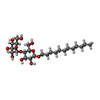
| #8: Sugar | ChemComp-LMT / |
|---|
-Non-polymers , 3 types, 126 molecules 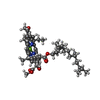

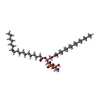


| #7: Chemical | ChemComp-BCL / #9: Chemical | ChemComp-CRT / #10: Chemical | ChemComp-PGV / ( |
|---|
-Details
| Has ligand of interest | Y |
|---|---|
| Has protein modification | Y |
-Experimental details
-Experiment
| Experiment | Method: ELECTRON MICROSCOPY |
|---|---|
| EM experiment | Aggregation state: PARTICLE / 3D reconstruction method: single particle reconstruction |
- Sample preparation
Sample preparation
| Component |
| ||||||||||||||||||
|---|---|---|---|---|---|---|---|---|---|---|---|---|---|---|---|---|---|---|---|
| Molecular weight |
| ||||||||||||||||||
| Source (natural) |
| ||||||||||||||||||
| Buffer solution | pH: 8 | ||||||||||||||||||
| Specimen | Conc.: 6 mg/ml / Embedding applied: NO / Shadowing applied: NO / Staining applied: NO / Vitrification applied: YES / Details: This sample was monodisperse. | ||||||||||||||||||
| Vitrification | Instrument: LEICA EM GP / Cryogen name: ETHANE / Humidity: 90 % / Chamber temperature: 277 K |
- Electron microscopy imaging
Electron microscopy imaging
| Experimental equipment |  Model: Titan Krios / Image courtesy: FEI Company |
|---|---|
| Microscopy | Model: FEI TITAN KRIOS |
| Electron gun | Electron source:  FIELD EMISSION GUN / Accelerating voltage: 300 kV / Illumination mode: FLOOD BEAM FIELD EMISSION GUN / Accelerating voltage: 300 kV / Illumination mode: FLOOD BEAM |
| Electron lens | Mode: BRIGHT FIELD / Nominal defocus max: 2700 nm / Nominal defocus min: 1100 nm / Cs: 2.7 mm / Alignment procedure: COMA FREE |
| Specimen holder | Cryogen: NITROGEN / Specimen holder model: FEI TITAN KRIOS AUTOGRID HOLDER |
| Image recording | Electron dose: 40 e/Å2 / Detector mode: COUNTING / Film or detector model: FEI FALCON III (4k x 4k) |
- Processing
Processing
| EM software |
| ||||||||||||||||||||||||||||||||||||
|---|---|---|---|---|---|---|---|---|---|---|---|---|---|---|---|---|---|---|---|---|---|---|---|---|---|---|---|---|---|---|---|---|---|---|---|---|---|
| CTF correction | Type: PHASE FLIPPING ONLY | ||||||||||||||||||||||||||||||||||||
| Particle selection | Num. of particles selected: 331335 | ||||||||||||||||||||||||||||||||||||
| 3D reconstruction | Resolution: 2.2 Å / Resolution method: FSC 0.143 CUT-OFF / Num. of particles: 126108 / Algorithm: FOURIER SPACE / Symmetry type: POINT | ||||||||||||||||||||||||||||||||||||
| Atomic model building | B value: 70 / Protocol: RIGID BODY FIT / Space: REAL / Target criteria: Correlation coefficient | ||||||||||||||||||||||||||||||||||||
| Atomic model building |
| ||||||||||||||||||||||||||||||||||||
| Refine LS restraints |
|
 Movie
Movie Controller
Controller


 PDBj
PDBj